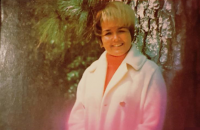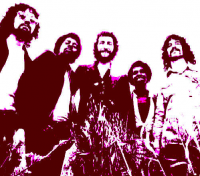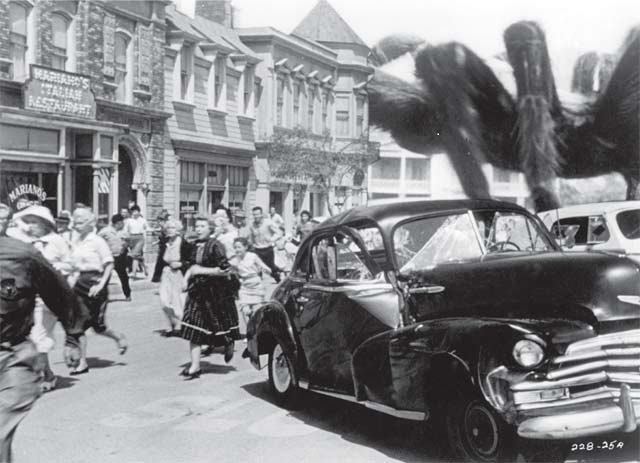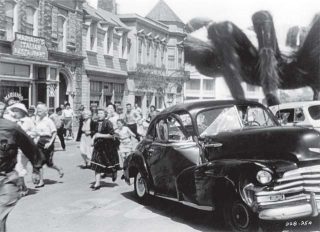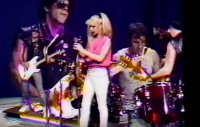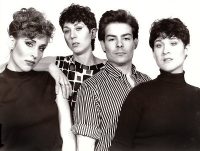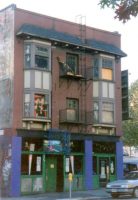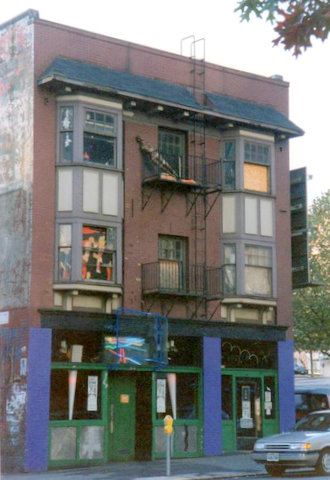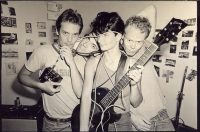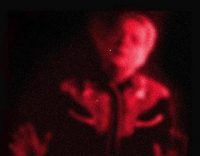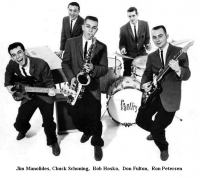
The story of The Frantics covers alot of NW music history. It’s also a tale of two bands…at least. The birth of what would become The Frantics goes back to 1955 when schoolmates Ron Petersen and Chuck Schoning formed a duo in 7th grade. They initially named themselves The Hi-Fi’s. Ron played guitar and Chuck playing accordian. Soon Chuck was loaned a keyboard and the band would expand with new recruits Joel Goodman (drums), Dean Tonkins (bass), and Gary Gerke (piano). After paring this line-up down to Ron Petersen, Joel Goodman, Chuck Schoning and Jim Manolides the band would become known as The Four Frantics. All members of The Four Frantics at this time were underage, so they hit the mighty teen dance circuit that was then at its height in the Northwest. Later Bob Hosko would sit in as sax player so the band shortened its name to The Frantics. By 1958 the band had gone through a few more personnel changes, heralding in the first classic line-up of the band. It was solidified with Ron Petersen (guitar), Joel Goodman (later, Don Fulton then, Jon Keliehor) on drums, Chuck Schoning (keyboards), Bob Hosko (saxophone), and Jim Manolides (bass). The band continued to play teen dances in the Puget Sound region, and by 1958 had become a local sensation. They’d also attracted the attention of local label Dolton Records.
The Frantics sound was simple. An incredibly tight rhythm section, highly proficient guitar playing and an up-front raunchy, R&B and Jazz influenced saxophone. The result was both fun, danceable and a bit dangerous. It was the sound of NW garage rock played with a little more finesse. The band was all-instrumental except for occassional appearances by locally in-demand vocalist Nancy Claire. Nancy made the rounds of the NW scene, both before and after her tenure with The Frantics, She played with the most iconic players of her era. Nancy Claire had such a high profile in the 60s that she will be covered in her own future post.
By 1959 The Frantics were slated to record for Dolton Records with prominent engineer Joe Boles in the basement studio of his West Seattle home. Boles was working with Dolton Records at the time and had done recordings and demos with soon-to-be-famous acts like The Fleetwoods, The Ventures and The Wailers. It was Boles himself that recorded The Ventures Walk Don’t Run and The Wailers Louie Louie, a song that became, and remains one of the seminal recording that would transform American Rock & Roll. Although The Frantics were wildly popular in the Northwest, their recorded output stalled in the nether regions of the national charts. Their three biggest national “hits” that made it into Billboard’s charts were Straight Flush that reached # 93 in the charts, Fog Cutter at #91 and their wildest outing Werewolf at #83. Their last charting success had been slated for a Hallowe’en release in 1959 , but because of delays wouldn’t be released until January of 1960. By that time it had lost it’s luster and missed the Halloween market it was intended for.
In 2012 a You Tube poster under the name “mroldies1″ (possibly Jim Manolides?) commented: ”I played bass in The Frantics. the original release (of Werewolf) had on the flip side a rocker called Checkerboard. When the payola scandal hit right as this record reached #53 (sic) with a bullet in its second week on the charts, the wolf howls were eliminated and ‘No Werewolf’ was on the b side of the re-release. the poem at the beginning is the voice of Bob Reisdorff (co owner of Dolton Records) the wolf howls are Kearney Barton, and the scream at the end is Bonnie Guitar (Dolton’s other co-owner) and there you have the truth.
The Frantics (like label-mates The Ventures) interpreted the popular tunes of the day, but wrote most of their own material. They also were not afraid to release what might be termed novelty records. Certainly tracks like Werewolf (with it’s spooky-sounding intro and howls) and The Whip (which featured noted bull whip performer Monty Whiplash) had a schtick-like quality, but the music itself went way beyond gimmicks.
One of their biggest successes up to that point came on the night of February 22nd 1959 when the band were chosen as Bobby Darin’s back-up band at Parkers Ballroom in north Seattle. Solo artists commonly travelled without a band in those days, and relied on advance men to choose musicians to play behind them in each city. Darin was impressed enough with The Frantics that he asked them to back him on some recordings at Joe Bole’s studio the next day. The band weren’t sure if Darin was serious, but quick arrangements were made to book the studio for the next morning, and as promised, Darin showed up with charts and lyrics for two songs he’d recently written: Dream Lover and Bullmoose. After a successful, amiable session Darin and the band parted ways. It was several months later that band members found out that Darin had taken the recordings to his label Atco.
The label loved the songs, but demanded they be re-recorded in NYC using professional studio musicians. The recording of Dream Lover and Bullmoose were produced by the famed Ahmet Ertegun and Jerry Wexler, but it was clear much of the songs’ arrangements were based on The Frantics original recordings with Darin. This is especially apparent in Darin’s new recording of Bullmoose. Fortunately the band and Boles had been paid for their time, and they laughed off the incident. This kind of thing was common in the early days of pop music. Dream Lover became one of Darin’s signature tunes as well as a multi-million seller, reaching #2 on the U.S. pop charts for a week and #4 on the R&B charts. In 1994 Darin’s son Dodd wrote that the song was a musical love letter to Dodd’s mother and Darin’s wife, Sandra Dee. The Frantics had missed out on a chance for widespread national recognition with Darin, but little did they know that some of the band’s members would later go on to make a more lasting mark.
https://youtu.be/axOrB2zuyPs
The Frantics remained a popular draw throughout the Pacific Northwest, British Columbia and up and down the US West Coast. Around this time Manolides left the group and was replaced by Jeno Landis. When the Seattle World’s Fair opened in 1962 the band were in the midst of a residency at Dave Levy’s’s club on 5th Avenue near the site of the fair They had all come of age and often played at local clubs and taverns. Throngs of Fair attenders flocked to Dave’s 5th Ave. to hear the band and The Frantics wrote and recorded the World’s Fair themed Meet Me In Seattle Twist and The Gayway Twist. The single went nowhere in the charts, but it made for a good souvenir from the World’s Fair. Collectors still search for mint copies of the flexi-disc.
Later that year musical differences between Chuck Schoning and Ron Petersen caused the band’s line-up to dissolve and then rise as two separate outfits. Schoning’s Frantics had left their teen image behind them and become a serious R&B influenced rock outfit. As more recordings were released by The Frantics. Petersen chose to re-christen his band as Ron Petersen and The Accents. His band later released one single (“Sticky” b/w“Linda Lou) on another of Seattle’s formidable ‘60s labels. Jerden Records. Meanwhile Schoner’s Frantics no longer took jobs in establishments geared to the teen crowd and hung out and jammed with serious Seattle legends like Little Bill Englehart, Dave Lewis, Mark Doubleday, Larry Coryell, Sarge West, Dicky Enfield, and Don Stevenson
From 1964 and onward The Frantics spent more and more time on the road and along with it came more personnel changes. One change involved adding Jerry Miller, a guitarist from Tacoma. After drummer Jon Keliehor was seriously injured in an automobile wreck (on his way to gigs in California) the band had to bring in Don Stevensen-an old friend from Seattle-to replace him. Various other members came and went and during a series of local gigs in California’s Bay Area. In the mid 60s the band was convinced to re-locate to the San Francisco area by a four-fingered guitarist playing in a band called The Warlocks. The guitarist later went on to become a founding member of The Grateful Dead, Jerry Garcia.
The Frantics became more and more influenced by the brewing San Francisco Sound, and were surrounded by the growing movement that was burgeoning in the Bay Area. They even began to dabble in psychedelia by recording a single featuring the songs Human Monkey b/w Someday, It was released by San Mateo based label, Action. It’s the only release by The Frantics not originally released on Dolton Records.
The band’s movement away from the traditional Frantics sound and toward the hippie-flower power, tie-dyed direction was causing another rift in the band, so by 1966 the band continued to change personnel Bob Mosely, a former San Diego bassist was added. Hosko threw in the towel and went back to Seattle. Chuck Schoning was dismissed. For a short time the band chose to work under the name Luminous Marsh Gas, but didn’t attract much of a following.
Shortly after the Frantics move to psychedelia, they were introduced to Skip Spence, the original drummer for Jefferson Airplane. He’d also been an early member of Quicksilver Messenger Service, and played guitar in The Other Side. Marty Balin was a fan of The Other Side and introduced Spence to theJefferson Airplane as a potential member. Spence played drums on the Jefferson Airplane debut album Jefferson Airplane Takes Off but was kicked out of the band and replaced by Spencer Dryden even before the album was released. Matthew Katz, the Airplane’s manager was also let go. He was just beginning to become one of the most unscrupulous characters to come out of San Francisco’s psychedelic scene. Spence and Matthew Katz had been joined forces and were searching for players for a new project. Peter Lewis-son of actress Loretta Young-had already signed on.
Spence and Katz had their eyes on The Frantics guitarist Jerry Miller and drummer Don Stevenson along with Bob Mosely, who had joined The Frantics shortly after their relocation to the Bay Area. All three of the Frantics agreed to join Lewis and Spence and it’s at this point The Frantics essentially morphed into one of the most important bands in rock history, Moby Grape. The name was supposedly thought up by Bob Mosley and Skip Spence, coming from the punch line of the somewhat corny riddle “What’s purple and swims?”
Shortly after forming the new line-up as Moby Grape the band decided that writing and singing was to be shared by all members, and the band would essentially allow all three guitarists (Spence, Miller and Lewis) to play leads with Mosely on bass and Stevenson as drummer. Soon Moby Grape was picked-up by Columbia Records and the began recording their first album. Critical and popular success came quickly as the band was constantly gigging. Their debut eponymous record is now regarded as one of the masterpieces of the psychedelic era and is regularly listed as one of the greatest recorded albums of all time. The highlight of the record may be the Skip Spence-penned Omaha. It’s a song that became a leading light of the San Francisco sound and regularly heard on radio stations around the world since it’s release. It’s a perennial favorite of critics and fans alike. In 2008 Rolling Stone’s Robert Christgau described the song as Moby Grape’s best single. He went on to add:
“Jerry Miller, Peter Lewis and Skip Spence compete in a three-way guitar battle for two and a quarter red-hot minutes, each of them charging at Spence’s song from different angles, no one yielding to anyone else.”
https://youtu.be/xqg3KEwDhvM
Unfortunately Moby Grape would be dogged by problems from the very beginning. They had to endure poor management, contracts, their label, their producer and worst of all, addiction and mental illness. In Jeff Tamarkan’s book Got a Revolution!: The Turbulent Flight of Jefferson Airplane he laments Moby Grape by writing:
“The Grape’s saga is one of squandered potential, absurdly misguided decisions, bad luck, blunders and excruciating heartbreak, all set to the tune of some of the greatest rock and roll ever to emerge from San Francisco. Moby Grape could have had it all, but they ended up with nothing, and less.”
Both Spence and Mosely were victims of mental illness and drug addiction. Spence was notorious for his outrageous and often inappropriate behavior. It’s what had earlier led to his firing by Jefferson Airplane. Many times his actions devolved into violence. Finally in 1968 Spence went over the edge during an LSD-fueled lapse into schizophrenia. He tried to chop down Don Stevenson’s door at The Apex Hotel in New York City. His intent, he said was “to save him from himself” by killing Stevenson. Spence had to be hospitalized for six months in Bellevue Hospital after this event. Even though his action had led to his dismissal from Moby Grape, Spence was often assisted by his former band mates during the course of his life.
An incident that shows the band’s failed management came when Moby Grape were slated to play one of the first outdoor rock festivals ever, the Monterey Pop Festival. Because of managerial disputes, Moby Grape was not included in the D.A. Pennebaker-produced film of the event, Monterey Pop. Footage of their performance remained unreleased until 2007 when it was included as part of the 40th anniversary celebration of the Pennebaker’s groundbreaking documentary. According to Peter Lewis, when questioned about their not appearing in the movie, he recalled:
“Katz (their manager) told Lou Adler (the festival’s organizer and promoter) they had to pay us a million bucks to film us at the Monterey Pop Festival. So instead of putting us on Saturday night right before Otis Redding, they wound up putting us on at sunset on Friday when there was nobody in the place.”
Obviously Adler was not amused by Katz’s demand
Soon after, another blow to the band occurred when in 1969 Mosely inexplicably quit the band to join the Marines. He was discharged a few months later and eventually ended up homeless, despite offers of help from his fellow bandmates. He had become embittered by a long dispute concerning the band’s ownership of their songs and, poor management and promotion and a dispute with their producer David Rubinson. The entire tragedy was caused by Katz making a settlement with Rubinson by Mosely that the band never knew about at the time. Mosely ended up living with addiction and mental illness on the streets for several years.
When Moby Grape was dismantled in 1971 the former Frantics members Jerry Miller and Don Stevenson joined up with John Barrett and John “Fuzzy” Oxendine to form The Rhythm Dukes. Don Stevenson played guitar, while Oxendine played drums. Stevenson preferred to play drums as he had in The Frantics and Moby Grape so he left the band shortly after it was formed. Upon Stevenson’s departure keyboardist Bill Champlin (formerly of The Sons of Champlin) signed on with the band. After The Rhythm Dukes disbanded Champlin embarked on a solo career and later became a member of the hugely popular band Chicago.
After a career with such potential Moby Grape dissolved and were left with legal problems, failure to be paid their royalties and a history of bad promotional moves by their label. They also had contractual obligations with Columbia Records dogging them and ongoing problems of who actually owned the name Moby Grape. That litigation would go on for decades. In total Moby Grape had released six albums and received adulation by a wide audience for their live shows and recorded output. Their debut album still remains a shining document of the era. Every one of their albums have been re-released as full albums and as compilations. There’s no doubt Moby Grape still have a huge fan base. But they gained nothing but headaches and heartaches for their efforts.
In 1983 original members of Moby Grape, Lewis, Miller, Mosley, and Stevenson re-united and held a concert that was recorded and released as Moby Grape: 1984. The band attempted on several occasions to reunite Moby Grape with a series of new members. Their attempts would not be realized until at least a decade later, with all but two original members-both of them original members of The Frantics, Jerry Miller and Don Stevenson.
In 1987 the band was re-united again, with the full original line-up of Moby Grape, along with It’s a Beautiful Day, Fraternity of Man, and The Strawberry Alarm Clock, for a couple of shows and also took part in a celebration of the 40th anniversary of The Summer of Love in San Francisco’s Golden Gate Park.
In the ensuing decades Miller and Stevenson have spent time spreading the gospel of The Frantics, as well as resting on their laurels as members of Moby Grape. They have re-popularized a band that may have only been a footnote in music history without them. In a very real way, Moby Grape would not have existed if it was not for their earlier work. In 1985 The Frantics took part in a reunion at the Seattle Center. The concert was held in celebration of the 25th anniversary of the Seattle World’s Fair. .
Here is a partial list of the aftermath of those who were associated with The Frantics and Moby Grape. It is by no means comprehensive and comments and corrections are welcome.
Jerry Miller has played alongside some of the greats of rock. Robert Plant has pointed to Miller as a major influence for Led Zeppelin and Eric Clapton once called Miller “the best guitar player in the world”. Rolling Stone magazine listed him at #68 as one of the ”100 Greatest Guitarists Of All Time”. Miller spends most of his time in Tacoma nowadays and gigs locally. He makes the occasional forays into the outside music world as a member of the re-constituted Moby Grape. In 2009 Miller took the place of Sky Saxon of The Seeds during the California 66 tour soon after Saxon’s death and in 2010 played a gig during that years SXSW music festival.
Don Stevenson returned to the NW and become successful in real estate. He currently resides in Whistler BC Canada. Stevenson also appeared with Moby Grape at the 40th anniversary San Francisco Summer of Love concert in Golden Gate Park. . In 2010, Stevenson performed with Jerry Miller and Omar Spence (son of Skip Spence) at SXSW in Austn. That same year he released his first solo album, King of The Fools. He is planning a second solo album and in the process of raising funds to release it through crowdsourcing. If you’d like to help go to www.gofundme.com/rjxswe-fund-my-grandpa
Bob Hosko went on to become a founding member of Jr. Cadillac but left after 1972. Seattle historian Paul Dorpat remarked in a post in 2008 that “Hosko died years ago”
Jon Keliehor returned to Seattle, recuperated from his auto accident and went on to be a founding member of The Daily Flash. Later he moved to the UK and now produces and records under his own name and leads music workshops in Glasgow, Scotland. His musical interests have evolved into exploration of esoteric, experimental and world music. According to his website his credits include music for the dance Class, The London Contemporary Dance Theatre, and for Troy Game, presented by the Royal Ballet. He is director of Dreamhouse, World Music Village in London and a co-composer of 1984 recording East Meets West (BRR18). The music Celestial Nile initiated collaborative works for Venezuelan dancers and company, Danzahoy, and resulted in the development of his current catalogue of recordings. He recorded and co-composed Trance Gong for Gamelan Pacifica in Seattle, and has worked with Gamelan Naga Mas in Glasgow, Scotland where he now lives.
.Chuck Schoning Joined Quicksilver Messenger and later recorded multiple albums under the name Chuck “Steaks” Schoning. He played on Southern Comfort’s 1970 “Who Knows” (Columbia Records) and Todd Rundgren’s 1972 breakthrough album Something/Anything (Bearsville Records) During his later years Chuck became organist for the Trinity Community Church in San Rafael CA and for Senior Access in San Anselmo. He died in San Rafael on March 3rd 2001
Jim Manolides became a well-loved music and art curator in Seattle and Ocean Shores WA. He bartended at Parnell’s jazz club in Seattle during the ’70s and ’80s, where he became the clubs’ most popular, most gregarious barman. Later he spent time behind the counter at Nickel Cigar, on Yesler Way. The space had earlier been The Manolides Gallery, an establishment Jim had opened in the early 1970’s. The last 13 years of his life he lived in Ocean Shores WA, where he died from a strok in May of 2016.
Joel Goodman is an Emmy Award-winning composer. According to his website Joel “creates music for narrative feature films, documentaries, television, album releases and other forms of collaborative media. Joel has scored over 125 films and television programs that have received 5 Oscar nominations, 20 Emmy awards and over 30 Emmy nominations. He has scored over 40 films for HBO and composed the Main Theme for the long-running and critically acclaimed PBS series American Experience. His scores can regularly be heard in movie theaters and on television around the world”.
Bob Mosely suffered from schizophrenia and ended up living on the streets until former Moby Grape members got him back to work and able to support himself. Despite his circumstances Mosely was able to continue writing and recording. He has released five solo albums since his time in Moby Grape. His most recent solo release is True Blue released on the Taxim label in 2005.
Skip Spence died of lung cancer on April 16 , 1999 just days short of his 53rd birthday. After his dismissal from Moby Grape Spence spent much of his life institutionalized due to his schizophrenia and the ravages of years of addiction to heroin, cocaine and alcohol. Soon after his release from NYC’s Bellevue Hospital in 1968 he managed to record the album Oar in Nashville. Many critics and fans consider Oar to be one of the most painful, confused and harrowing albums of all time. Multiple celebrations of his life were held immediately after Spence’s death, and every once in a while another event is celebrated to highlight his brilliant contribution to psychedelic rock. In 1999 shortly after Spence’s death a tribute album was released. More Oar: A Tribute To The Skip Spence Album, The collection had contributions from Seattle-related musicians Mark Lanegan, Mudhoney and Minus 5 (a band formed by Young Fresh Fellows’ Scott McCaughey that includes a revolving cast including Barrett Martin, Jenny Conlee, Peter Buck, John Ramburg, Linda Pitmon, Jon Auer, Bill Reiflin, Ken Stringfellow, Kurt Bloch, Mike McCready, Jeff Tweedy, Chris Belew, Anna Shelton and Mike Mills among others in the constantly changing line-up that are all attached to the Seattle music scene…either directly or tangentially.
Peter Lewis is still writing and performing as a member of the presently re-constituted Moby Grape and the reformed Electric Prunes,
Any updates or corrections are welcome
-Dennis R. White. Sources; “The Frantics: Seattle’s Top Teenage ‘50s Band” by Peter Blecha, “NW Music Archives” (1984); “Got a Revolution!: The Turbulent Flight of Jefferson Airplane” by Jeff Tamarkan (Atria, 2003); “Dolton Album Discography” by David Edwards and Mike Callahan (bnspubs.com, November 2005); “Moby Grape Just Can’t Catch A Break” (NPR.com, December 21, 2007); “The Frantics” by Joel Goodman (PNW Bands, October 2003); “The Frantics” by Jon Keliehor (PNW Bands,December 2007 & April 2009). “The Frantics-Complete Recordings on Dolton” (Collectors Choice Music, 2004); “40 Essential Albums of 1967” by Robert Christgau and David Fricke (Rolling Stone July 12, 2007):“Jimmy Manolides, a Seattle musician and art curator, dies at 76” by Paul de Barros (SeattleTimes, May 12th, 2016) “Moby Grape” Wikipedia entry, 26 June 2017, fact-checked by Dennis R. White, August 14th 2017); Jerry Miller official website (jerrymillerband.com); “Welcome to the Bob Mosley Website!” Bob Mosely official website (bobmosley.com); “The Frantics – Human Monkey” by theblog11(Psychotic Reactions and Carburetor Dung, January 25th, 2014); You Tube comment by mroldies1, (You Tube 2012); Jon Keilihor, (personal website at jonkeliehor.com); Joel Goodman (personal website at joelgoodman.com); discogs.com; photograph copyright Liberty Records.



